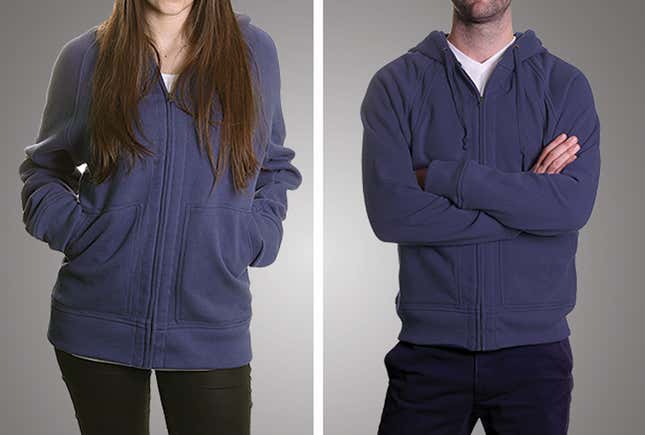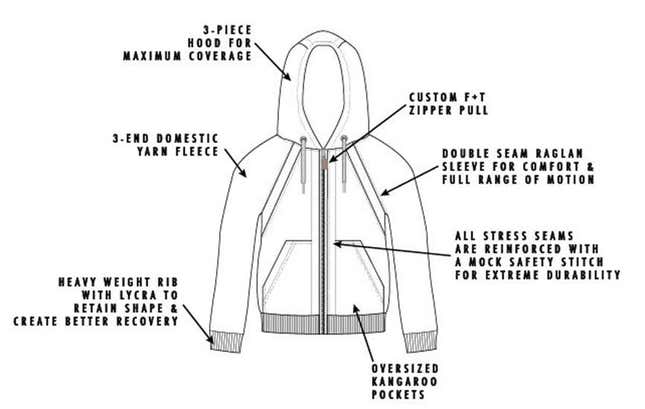
Jake Bronstein is a startup guy in a startup uniform: sweatshirts and hoodies. He wears them year-round, almost every day. Of course, they wear out often.
“I’ve probably owned like 40 of them,” he said.
So Bronstein and his small New York-based company, Flint and Tinder, are expanding from making underwear to making hoodies, those hooded sweatshirts that are the mainstay of teens and twentysomethings’ wardrobes. Their new sweatshirts will come with a 10-year guarantee, which includes free mending.
Ten years is a somewhat incredible time frame in the world of fashion and apparel, where new lines debut twice a year and new companies rise and fall in two or three. It’s also quite a commitment from a company that has been in business for barely a year. Flint and Tinder says it wants to nudge consumers toward buying something that will endure, and not be part of the world of planned obsolescence. (And surely it feels the same about its own prospects for longevity.)

Flint and Tinder’s hoodie should last 10 years, Bronstein said, because of the fabric, which is a three-gauge knit made in the US, constructed with reinforced sewing and “double reinforced ribbing” along the bottom and wrists, areas that are prone to fraying. Bronstein wants the hoodie to become the ”Swiss Army Knife of fashion,” combining function with fashion.
“Mark Zuckerberg will live in his and Barack Obama will wear one on the weekend. It works for everybody in every situation,” he said.
Flint and Tinder started by raising almost $300,000 in a May 2012 Kickstarter campaign to sell Made In America men’s underwear, which created a problem since he wasn’t prepared to produce that much inventory.
At the time, he was working solo in his basement and had no apparel or design experience. Almost a year later, Flint and Tinder has eight employees and is building a factory scheduled to open later this year in Las Vegas, thanks to venture funding by Zappos founder Tony Hseih and others.
His current Kickstarter for the hoodies has more than $700,000 in pledges by 6,400 backers.
“Ignorance is the father of innovation,” he said, choosing his words carefully. Sometimes it’s better not to overthink or know all about your project when you commence. “If I understood how much trouble was going to come along and how many hurdles, I never would have done it.”
Yet hoodies certainly work as a consumer purchase. Americans bought $2.81 billion in hoodies in the last year, a 5.9% increase in sales since 2010, according to NPD Group, a global information and consumer tracking company. If every hoodie costs, say, $50 (a mid-range price), that would mean that approximately 56.2 million zipped out of stores.
Most are imports from Vietnam, Guatemala or elsewhere. Last year, businesses imported $76.8 billion in all kinds of apparel at wholesale prices, down about 1% increase from 2011, according to the US Department of Commerce. The department does not track hoodie imports.
The hoodies will be available in navy blue, red, black, gray and army green and come with the 10-year guarantee. Bronstein isn’t thinking about price until I ask about it. Then he googles prices for J.Crew hoodies and notes they go for $78 to $118, and his costs about $20 more than American Apparel sweatshirts.
“The $89 price is going to be less than a beer a year,” he said. (A cheap six-pack or a good pricey pint, that is.)
Consumers probably buy a new hoodie every two years, at perhaps $65 each, Bronstein estimates. That’s $310 spent over 10 years, so the Flint and Tinder $89 hoodie could save them $221.
The 10-year guarantee already is raising questions from Kickstarter backers: What if the customer ran through barbed wire or cut up the hoodie? Answer: Fix it, either using thread to match the color or a contrasting one to create: ”In my fantasy world, it will look like we tattooed this piece” with colorful repairs, Bronstein said.
His team tested two prototypes by cutting them up, and resewing them, wearing them around Brooklyn and putting them through the ringer, er, dryer. His firm bought a machine that emulates 10 washes and 10 dryer cycles at a time. “We put this thing through that many many times,” he said. Those calculations helped him figure the Flint and Tinder hood could “live for more than a decade.”